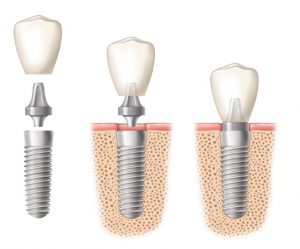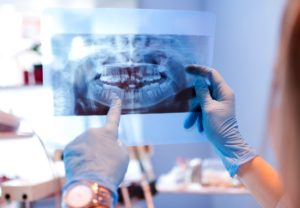Header logo
header top contact widget
Implant Placement
Know The Unseen Risks Of Wearing Dentures
Posted on Sep 19, 2019 by William J. Claiborne, DDS MS
As an Asheville periodontist, my goal is to provide each patient with the very best so they can enjoy a healthy, confident smile. For patients who have lost one or more natural teeth, some come to me because they want to avoid ending up having to wear a full or part ial denture. For those who wear one and are unhappy with the feel and function, we are sought out as specialists in the diagnosis and placement of dental implants.
ial denture. For those who wear one and are unhappy with the feel and function, we are sought out as specialists in the diagnosis and placement of dental implants.
Denture wearers, especially those who have worn dentures for many years, can quickly become dissatisfied with the uncomfortable rubbing and difficulty eating foods they once enjoyed. Although their ‘appliance’ may have fit well when first made, changes in the fit, over time, are due to what is taking place below the gum tissues. These changes aren’t obvious, at first.
When first made, a denture is custom-designed to fit snugly to the unique contours of the gum ridge. This ‘ridge’ is the raised arch where natural teeth were once held. Over time, denture wearers begin to notice that the denture moves while chewing certain foods. This can rub sore spots on gums. As the denture loosens more, even using denture adhesives or pastes don’t help much.
Denture patients also learn that it can be painful for something as small as a sesame seed to become trapped between their denture and gums, piercing into tender gum tissues. Some people eventually switch to a diet of soft foods that dissolve easily to avoid rigorous chewing. Because of fear of embarrassing slips, others begin to decline social invitations when they are centered around food.
The problem for a denture wearer is what is happening underneath the gums. The looser fit is not because the denture has expanded – it’s the decline of the jaw bone. This occurs with the absence of tooth roots, which once provided nourishment and stimulation to the bone that supported them.
When natural tooth roots are removed, the jaw bone begins to shrink. This decline in bone mass also contributes to changes in facial appearance, such as deep wrinkling around the mouth and the formation of jowls.
The process of bone loss continues as the gum ridge your denture was contoured to flattens. Relines may temporarily adjust the denture to accommodate some of the change. However, as the jaw bone continues to decline, the denture continues to be difficult to keep in place.
The denture itself merely adds to the problem of bone loss. The pressure of wearing a denture actually accelerates the rate of bone loss. Since a number of denture wearers also sleep in their dentures, the 24/7 pressure speeds this rate even more.
Long-time denture wearers often complain that they are not able to chew, with some admitting they have to even remove their denture to eat. Fear of embarrassment is another common complaint. Speaking, laughing and even sneezing in the presence of others can create embarrassing moments that leave lasting impressions.
The solution to these problems – dental implants. Not only do implants restore the ability to bite and chew comfortably, they halt bone loss that is associated with dentures. Because they are held by the jaw bone, just as natural tooth roots once were, implants recreate the stimulation needed by the jaw bone to maintain its mass.
Does your denture bring to mind words like rocky, wobbly and slippery? If so, the problem will only worsen over time. When people choose dental implants to replace an ill-fitting denture, they can smile, laugh and chew with confidence.
Eating a healthy diet, socializing with friends and family, and feeling confident are essential to a healthy, happy life. Call our friendly Asheville periodontal dental office: 828-254-9440 to schedule an initial appointment. (A referral is not required). During this time, I’ll explain the type of implants that may be best for your needs as well as comfort options, including oral and IV sedation (“twilight sleep”). We are also happy to discuss estimated costs and payment options.
Using A Manual Or Electric Toothbrush Could Make A BIG Difference.
Posted on Sep 11, 2019 by William J. Claiborne, DDS MS
If you use an electric toothbrush, that can help in the prevention of tooth loss. However, it’s but one part of the steps needed for thorough oral hygiene at home.
Findings of an 11 year study published in the Journal of Clinical Periodontology tracked the oral health of over 2800 adults. Their use of electric toothbrushes was monitored to watch for periodontal disease, cavities, and the number of natural teeth.
Participants were examined in 2002 – 2006, with 18 percent being electric tooth brush users. Follow ups were conducted after six and 11 years. At the time of their 11 year follow up, 37 had converted to using electric toothbrushes.
The study showed electric brushing promoted better gum health and slower progression of gum disease. Electric tooth brushing also related to a reduction in tooth loss by 20 percent (compared to those who brush with manual toothbrushes). The study did not reveal measurable reduction in cavities, however.
Although more adults are using them, their long-term effectiveness has not been proven to be significant. It is suspected that this is due to technique more than the brushing tool itself. For manual brushers, a major hazard with manual brushes is one’s choice of bristles. Stiffer bristles can be very damaging.
If you use a hard bristle tooth brush, you may be damaging tooth enamel and gum tissues. People often feel they need to press down firmly as they brush and use a scrubbing, ‘back & forth’ motion. This action can wear down the protective shell of tooth enamel, leaving teeth more vulnerable to decay.
Another problem with using a hard bristle tooth brush is its ability to damage tender gum tissues. If the bristles on your toothbrush are fanned out after a couple of months, it’s because you are applying too much pressure when brushing.
The ideal technique for brushing teeth is applying gentle pressure on the brush in a swirling motion. By using a circular pattern over both sides of each tooth and along the tops, teeth are cleansed without wearing away gum tissues.
This is where electric toothbrushes can help greatly. Many of the newer models include timers to indicate the time needed for each quadrant of your mouth. This is your teeth divided into 4 sections. They also warn you when you are using too much pressure.
While tooth enamel is important, equally so are the health of your gum tissues. The gums provide a seal around the base of each tooth. This seal helps to prevent the entry of bacteria that can lead to periodontal (gum) disease, which the nation’s leading cause of adult tooth loss.
As devastating as tooth loss can be to one’s overall health, as we now know that the bacteria of gum disease can enter the bloodstream. Research has shown this infectious bacteria can trigger inflammatory reactions elsewhere in the body, correlating to heart disease, stroke, high blood pressure, some cancers, diabetes, arthritis, impotency, preterm babies and more.
Whether using a manual or electric tooth brush, it is necessary to brush twice a day for effective results. In order to thoroughly remove the sticky film of plaque from teeth, you should also brush at least two minutes each time.
Plaque is a buildup of oral bacteria that coats teeth and gums. If not removed daily, it forms a hardened mass of calculus (or tartar) that attaches to teeth. This is what you may feel your hygienist scraping off teeth during cleanings since it cannot be brushed or flossed away.
Another place for oral bacteria to thrive are the grooves in the tongue. These offer a dark, warm and moist environment for bacterial reproduction. To uproot these organisms (that reproduce rapidly), use your toothbrush to brush your tongue after brushing teeth. Be sure to reach the back of the tongue where the majority of oral bacteria are embedded. Swish with water several times after.
Another way to improve gum health, lower cavity risk, and prevent tooth loss is through flossing. It is estimated that only 31 percent of American adults floss on a daily basis. Because brushing cannot dislodge all food particles caught between teeth, daily flossing should be a part of oral hygiene routines.
Flossing removes trapped bits of food remain in the mouth, which feeds oral bacteria and helps them to quickly multiply. Proper flossing is easy for those who are in the habit of it and takes under a minute each day. For those who have problems with manual dexterity or find the maneuver awkward, water flossers are effective alternatives and easy to use.
Practice the recommended techniques mentioned above and you’ll not only do a better job at having a clean mouth, you’ll find your time at the sink requires less effort. If you feel you may be experiencing symptoms of periodontal disease, however, don’t delay. You should be seen at your earliest convenience for treatment since this disease will only worsen over time.
Signs of gum disease include tender gums that bleed easily when brushing, gums that darken in color to red (versus a healthy pink), frequent bad breath, and gums that pull away from teeth (receded gums) and expose darker root areas of the tooth.
If you’ve noticed any of these, please know that the condition will only worsen without treatment. As a periodontist, I specialize in gum tissues (as well as dental implants). Our environment optimizes patient outcomes and comfort throughout treatment.
Call 828-274-9440 to learn more.
Dental Implants – Many Types Available For Different Needs & Preferences
Posted on Jul 10, 2019 by William J. Claiborne, DDS MS
As a periodontist, an area of my dental specialty includes advanced training in the diagnosis and placement of dental implants. This specialized expertise provides implant patients with a high level of success in treatment outcome. It also offers patients a wider variety of choices when it comes to implant systems.
When dental offices offer dental implants, some general dentists refer the placement portion to a periodontal specialist. For their patient, this can mean a higher level of success, especially for complex needs.
For example, a patient who is missing a lot of bone mass (often due to missing natural teeth for many years) benefits from the specialized skills of our Asheville periodontal office. Another example is a patient who has lost teeth due to periodontal (gum) disease. Because a periodontist combines advanced skills in treating gum disease as well as in dental implants, these patients are given a ‘leg up’ when it comes to treatment success.
Dental implant diagnosis and placement skills can vary greatly when offered by general dentists. While some have taken extensive courses in implant dentistry, others may have taken a weekend course here and there. These are typically ‘hosted’ by a particular manufacturer who provides ‘training’ in a limited selection of implant types. In turn, this can limit the patient’s choices when relying on appropriate recommendations for his or her unique needs.
Now seen as the preferred option for tooth replacement, dental implants are available to accommodate various challenges and preferences. There are numerous choices available. Some of the more common include:
Traditional Dental Implants: In this process, dental implants includes a couple of stages. Implant placement is performed first. This involves small incisions in pre-selected placement points. These points are determined through computerized imaging, taking the guesswork out of the depth and angle of each implant placed. Once the implant is in proper position, the gum tissue is closed over the implant sites.
For a ‘healing period’ of 3-6 months, the bone grows around the implants to secure each in place. This process is referred to as ‘osseo-integration,’ which describes the bone growing around the implanted portion. The process is similar to a rope tied around the branch of a tree. Over time, the branch grows around the rope. Osseo-integration is similar to this but occurs at a much more rapid pace.
After several months, the implant sites are uncovered and a post is positioned inside each implant. Onto the posts, the replacement teeth are secured. Rest assured, during the healing phase, patients are able to wear their denture or partial comfortably. Once the final teeth are attached, patients can enjoy their ‘new’ smile along with the biting and chewing comfort like that of natural teeth.
Non-Removable Teeth Attached To Implants: In the past, the more affordable ‘full arch’ systems were typically those designed to support removable teeth. (An ‘arch’ replaces all upper or all lower teeth.) However, some people feel removable teeth are too similar to the denture they have (and detest). Although firmly secured, the chore of having to remove their new teeth to clean is undesirable to many people.
A number of implant systems are available, designed to provide non-removable options that are more affordable. For example, the All On 4 dental implant system is made to support non-removable teeth, often on just 4 implants. With the implanted portions placed at unique angles, these longer implants can fully distribute biting and chewing forces.
Another advantage of All On Four is their ability to be placed in minimal bone. This is good news for people who are long-time denture wearers and were told they have too little bone to support implants. Or, they may have been advised to have bone grafts to rebuild the bone to an adequate height. This adds time and expense to implant treatment. Often, the All On 4 design is able to overcome this obstacle.
‘Same-Day’ Dental Implants: With advanced implant systems and technology, implant placement and teeth attachment can be accomplished in a single day. Advanced implant designs can position implants in the jaw bone that are ready to support replacement teeth. With the replacement teeth created prior, the teeth may be attached without delay. In some cases, a previously-made denture or partial can be reconfigured to attach to newly placed implants. “Implants in a day” isn’t wise for all situations, however. This option should be diagnosed and performed by a skilled, experienced professional who understands both the requirements and limitations involved. Putting your care in the hands of an experienced, skilled and highly-trained dental specialist is the best way to achieve a successful outcome. Just a note – while these quick-&-easy procedures can sound appealing, be cautious of ‘clinic’ settings who promote same-day implants. For an optimal outcome, choose care where your individual needs are a priority, rather than corporate profit goals.
Modern implant dentistry is successful, safe, dependable and can provide nearly immediate benefits. As a dental specialist who has stayed on the cutting edge of implant dentistry’s techniques, technology and materials, I am pleased to witness the transformations our patients undergo after treatment.
Dental implants are designed to last a lifetime and the closest thing to the natural teeth you once had. Too, the restored ability to bite, chew, speak and laugh confidently and even sneeze without worry can provide a tremendous boost to one’s self-esteem, self-confidence.
The type of dental implant best suited for you can be determined after an examination and review of x-rays (we use Cone-Beam digital imaging). Call 828-274-9440 to begin with a private, no obligation consultation to discuss your best options.
Get The Most For Your Investment When Replacing Teeth.
Posted on Jun 12, 2019 by William J. Claiborne, DDS MS
Losing a natural tooth is a big deal. Its loss not only leaves a gap in the appearance of a smile, its absence can lead to movement of surrounding teeth. 
Without all teeth in their proper positions, an open area can cause others to tilt and turn. Additionally, the one above or below will grow longer without having its ‘roommate.’ These issues can lead to broken, fractured, or chipped teeth.
Replacing a tooth involves decisions, and costs. While there are ‘cheap’ ways to replace a tooth, the ideal method – a dental implant – offers lifetime replacement that actually enhances the well-being and lifespan of surrounding teeth.
In dental implant treatment, the ‘implanted’ portion is positioned into the jaw bone as a tooth root replacement. This provides the teeth attached the same foundation as natural tooth roots have. A partial or bridge simply sits on top of gum tissues and relies on adjacent teeth for support.
When a tooth must serve as a support for ‘prosthetic’ teeth, its key role becomes greater. With the added pressure and stress to the natural tooth, there are also more risks to its structure on its own.
Because of the ability to restore the presence of natural teeth to such a great extent, dental implants are the preferred choice for replacement. Although the costs seem greater, over time, the benefits far outweigh the expense. This is why more and more adults are choosing implants to replace one, several, or all missing teeth.
However, there are many factors that can come into play when going forward with a dental implant. Your choice of doctor to place the implanted portion can greatly increase your potential to enjoy your dental implant for a lifetime.
As a Periodontist, my specialty encompasses treatment of all levels of gum disease, the re-contouring of gum tissues, and advanced training in the diagnosis and placement of dental implants. This includes the proper selection of the implant type best for each patient’s needs as well as placement at correct depths and angles.
The most troubling thing I see in implant dentistry is when a patient opted for a “good deal” with a less-experienced doctor, and having to remove a ‘failed’ implant.
Along with an intricate knowledge of the specific type of implant needed, proper placement angles and depth have much to do with the overall success of the implant. For optimal results, the doctor placing the implant should be skilled in the selection of the implant angles and positioning depths.
For example, an implant placed in the upper jaw in too-shallow bone can work its way into the sinus cavity. A lower implant in insufficient bone depth can reach a nerve that runs horizontally through the lower jaw (the mandible).
Additionally, the shape, size and the number of teeth to be attached to an implant have much to do with the type of implant system selected. When the placement doctor is only familiar with one or two types, disasters can occur.
In our Asheville periodontal office, we enjoy restoring the health and appearance of smiles. We also help patients who once struggled with dentures or partials to resume eating the foods they love again and laugh confidently in social gatherings.
The doctor is not the sole factor in success, however, Along with proper selection and placement, a patient must take measures to ensure proper oral hygiene at home. Oral bacteria can contribute to an infection that works its way into the bone surrounding the implant. In some cases, the only way to resolve the infection is to remove the implant.
When a patient entrusts their implant treatment to a skilled doctor and adheres to hygiene and healing guidelines, having an implant fail is very unlikely. The success rate of today’s implant dentistry is excellent – over 97 percent.
If you are considering dental implants, increase your potential for a successful outcome by asking a Periodontist to join your dentist in team treatment. Most general dentists have close relationships with periodontal specialists for implant placement and in treating gum disease.
Feel free to discuss your specific needs and desires before you make your decision. Call (828) 274-9440 to schedule a consultation.
Recent Posts
Categories
Archives
- September 2024
- August 2024
- July 2024
- June 2024
- May 2024
- April 2024
- March 2024
- February 2024
- January 2024
- December 2023
- November 2023
- October 2023
- September 2023
- August 2023
- July 2023
- June 2023
- May 2023
- April 2023
- March 2023
- February 2023
- January 2023
- December 2022
- November 2022
- October 2022
- September 2022
- August 2022
- July 2022
- June 2022
- May 2022
- April 2022
- March 2022
- February 2022
- January 2022
- December 2021
- November 2021
- October 2021
- September 2021
- August 2021
- July 2021
- June 2021
- May 2021
- April 2021
- March 2021
- February 2021
- January 2021
- December 2020
- November 2020
- October 2020
- September 2020
- August 2020
- July 2020
- June 2020
- May 2020
- April 2020
- March 2020
- February 2020
- January 2020
- December 2019
- November 2019
- October 2019
- September 2019
- August 2019
- July 2019
- June 2019
- May 2019
- April 2019
- March 2019
- February 2019
- January 2019
- December 2018
- November 2018
- October 2018
- September 2018
- August 2018
- July 2018
- June 2018
- May 2018
- April 2018
- March 2018
- February 2018
- January 2018
- December 2017
- November 2017
- October 2017
- September 2017
- August 2017
- July 2017
- June 2017
- May 2017
- April 2017
- March 2017
- February 2017
- January 2017
- December 2016
- November 2016
- October 2016
- September 2016
- August 2016
- July 2016
- June 2016
- May 2016
- April 2016
- March 2016
- February 2016
- January 2016
- December 2015
- November 2015
- October 2015
- September 2015
- August 2015
- July 2015
- June 2015
- May 2015
- April 2015
- March 2015
- February 2015
- January 2015
- December 2014
- November 2014
- October 2014
- September 2014
- August 2014
- July 2014
- June 2014
- May 2014
- April 2014
- March 2014
- February 2014
- January 2014
- December 2013
- November 2013
- October 2013
- September 2013
- August 2013
- July 2013
- June 2013
- May 2013
- April 2013
- March 2013
- February 2013
- January 2013
- December 2012
- November 2012
- October 2012
- September 2012
- August 2012
- July 2012
- June 2012


